Abstract
Neuropathic pain is a debilitating condition for which the development of effective treatments has been limited by an incomplete understanding of its chemical basis. We show by using untargeted metabolomics that sphingomyelin-ceramide metabolism is altered in the dorsal horn of rats with neuropathic pain and that the upregulated, endogenous metabolite N,N-dimethylsphingosine induces mechanical hypersensitivity in vivo. These results demonstrate the utility of metabolomics to implicate unexplored biochemical pathways in disease.
This is a preview of subscription content, access via your institution
Access options
Subscribe to this journal
Receive 12 print issues and online access
$259.00 per year
only $21.58 per issue
Buy this article
- Purchase on Springer Link
- Instant access to full article PDF
Prices may be subject to local taxes which are calculated during checkout


Similar content being viewed by others
References
Torrance, N., Smith, B.H., Bennett, M.I. & Lee, A.J. J. Pain 7, 281–289 (2006).
Warfield, C.A. & Fausett, H.J. Manual of pain management. in Manual of Pain Management (eds. Warfield, C.A. & Fausett, H.J.) 193–199 (Lippincott Williams & Wilkins, 2002).
Woolf, C.J. & Mannion, R.J. Lancet 353, 1959–1964 (1999).
Singh, O.V. et al. Proteomics 9, 1241–1253 (2009).
Sung, Y.J. & Ambron, R.T. Neurol. Res. 26, 195–203 (2004).
Hofmann, H.A., De Vry, J., Siegling, A., Spreyer, P. & Denzer, D. Eur. J. Pharmacol. 470, 17–25 (2003).
Hannun, Y.A. & Obeid, L.M. Nat. Rev. Mol. Cell Biol. 9, 139–150 (2008).
Ogretmen, B. & Hannun, Y.A. Nat. Rev. Cancer 4, 604–616 (2004).
Latorre, E., Aragones, M.D., Fernandez, I. & Catalan, R.E. Eur. J. Biochem. 262, 308–314 (1999).
Göggel, R. et al. Nat. Med. 10, 155–160 (2004).
Woolf, C.J., Shortland, P. & Coggeshall, R.E. Nature 355, 75–78 (1992).
Knyihár-Csillik, E., Rakic, P. & Csillik, B. Cell Tissue Res. 247, 599–604 (1987).
Inoue, M. et al. Nat. Med. 10, 712–718 (2004).
Igarashi, Y. et al. J. Biol. Chem. 265, 5385–5389 (1990).
Lee, Y.K., Kim, H.L., Kim, Y.L. & Im, D.S. Mol. Cells 23, 11–16 (2007).
Nie, H. & Weng, H.R. J. Neurophysiol. 103, 2570–2580 (2010).
Scholz, J. & Woolf, C.J. Nat. Neurosci. 10, 1361–1368 (2007).
Watkins, L.R., Milligan, E.D. & Maier, S.F. Trends Neurosci. 24, 450–455 (2001).
Alexander, G.M., van Rijn, M.A., van Hilten, J.J., Perreault, M.J. & Schwartzman, R.J. Pain 116, 213–219 (2005).
Wolf, G., Gabay, E., Tal, M., Yirmiya, R. & Shavit, Y. Pain 120, 315–324 (2006).
Gao, Y.J. et al. J. Neurosci. 29, 4096–4108 (2009).
Coste, O. et al. J. Biol. Chem. 283, 32442–32451 (2008).
Edsall, L.C., Van Brocklyn, J.R., Cuvillier, O., Kleuser, B. & Spiegel, S.N. Biochemistry 37, 12892–12898 (1998).
Morales, P.R. et al. Drug Chem. Toxicol. 30, 197–216 (2007).
Igarashi, Y. & Hakomori, S. Biochem. Biophys. Res. Commun. 164, 1411–1416 (1989).
Acknowledgements
This work was supported by the US National Institutes of Health (NIH) R24 EY017540-04 (G.S.), P30 MH062261 (M.M., G.S.) and P01 DA026146-02 (G.S.) in addition to RR025774 (M.M.); NIH–National Institute of Aging L30 AG0 038036 (G.J.P.); and NIH–National Institute of Neurological Disorders and Stroke F32NS068015 and T32 NSO41219 (L.P.S.). We also acknowledge financial support from the US Department of Energy FG02-07ER64325 and DE-AC0205CH11231).
Author information
Authors and Affiliations
Contributions
G.J.P. and O.Y. contributed equally to this work. G.J.P., L.P.S. and J.C. performed work on rats. G.J.P., O.Y. and L.P.S. performed analytical experiments. G.J.P., O.Y., L.P.S., J.-P.C., R.T., M.M. and G.S. contributed to experimental design, performed data analysis and wrote the manuscript.
Corresponding authors
Ethics declarations
Competing interests
The authors declare no competing financial interests.
Supplementary information
Supplementary Text and Figures
Supplementary Methods and Supplementary Results (PDF 4511 kb)
Rights and permissions
About this article
Cite this article
Patti, G., Yanes, O., Shriver, L. et al. Metabolomics implicates altered sphingolipids in chronic pain of neuropathic origin. Nat Chem Biol 8, 232–234 (2012). https://doi.org/10.1038/nchembio.767
Received:
Accepted:
Published:
Issue Date:
DOI: https://doi.org/10.1038/nchembio.767
This article is cited by
-
Guiding the choice of informatics software and tools for lipidomics research applications
Nature Methods (2023)
-
Gut microbiota depletion by antibiotics ameliorates somatic neuropathic pain induced by nerve injury, chemotherapy, and diabetes in mice
Journal of Neuroinflammation (2022)
-
Lipid and metabolic alteration involvement in physiotherapy for chronic nonspecific low back pain
Lipids in Health and Disease (2022)
-
Salivary metabolites associated with a 5-year tooth loss identified in a population-based setting
BMC Medicine (2021)
-
Spinal mechanisms contributing to the development of pain hypersensitivity induced by sphingolipids in the rat
Pharmacological Reports (2021)



